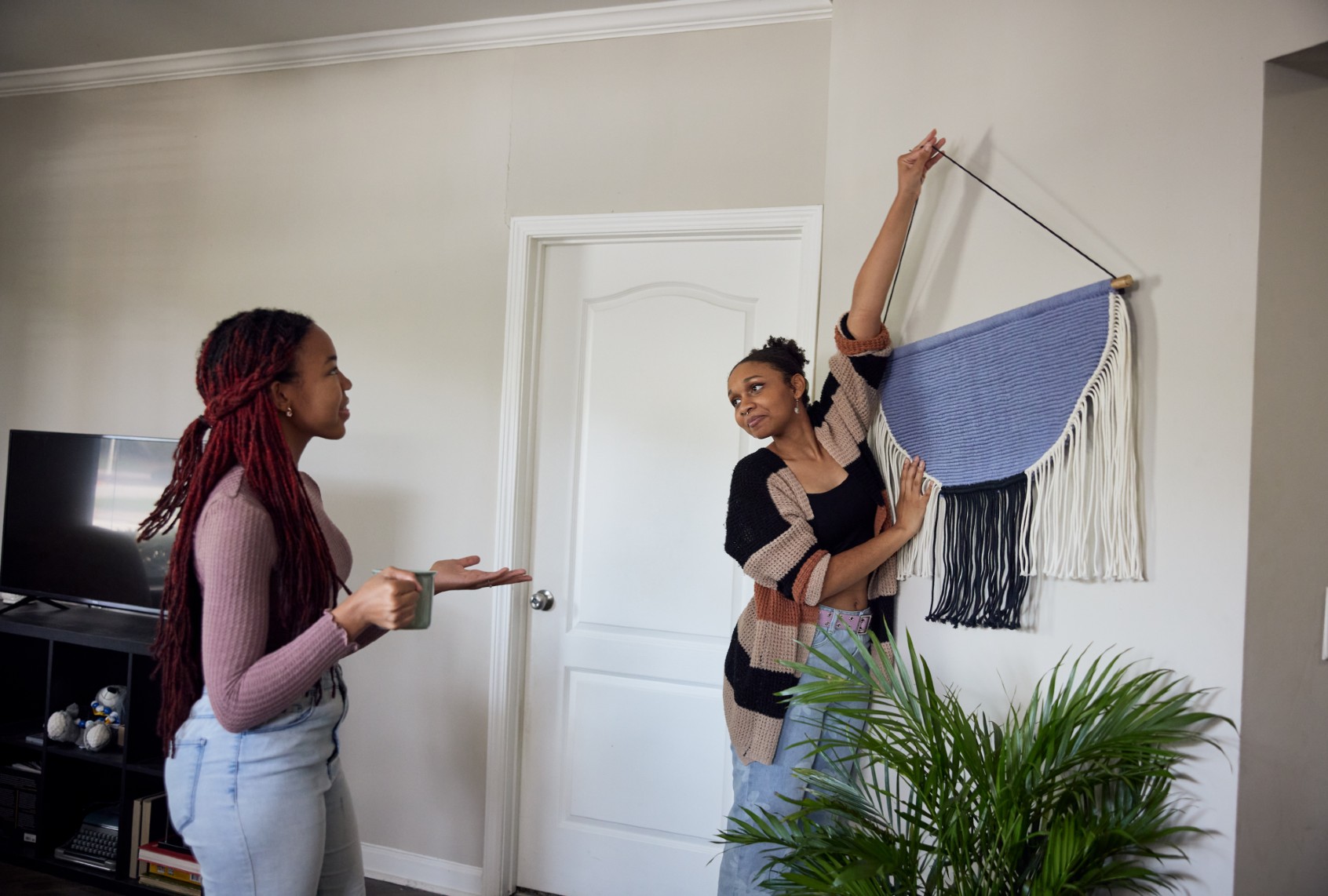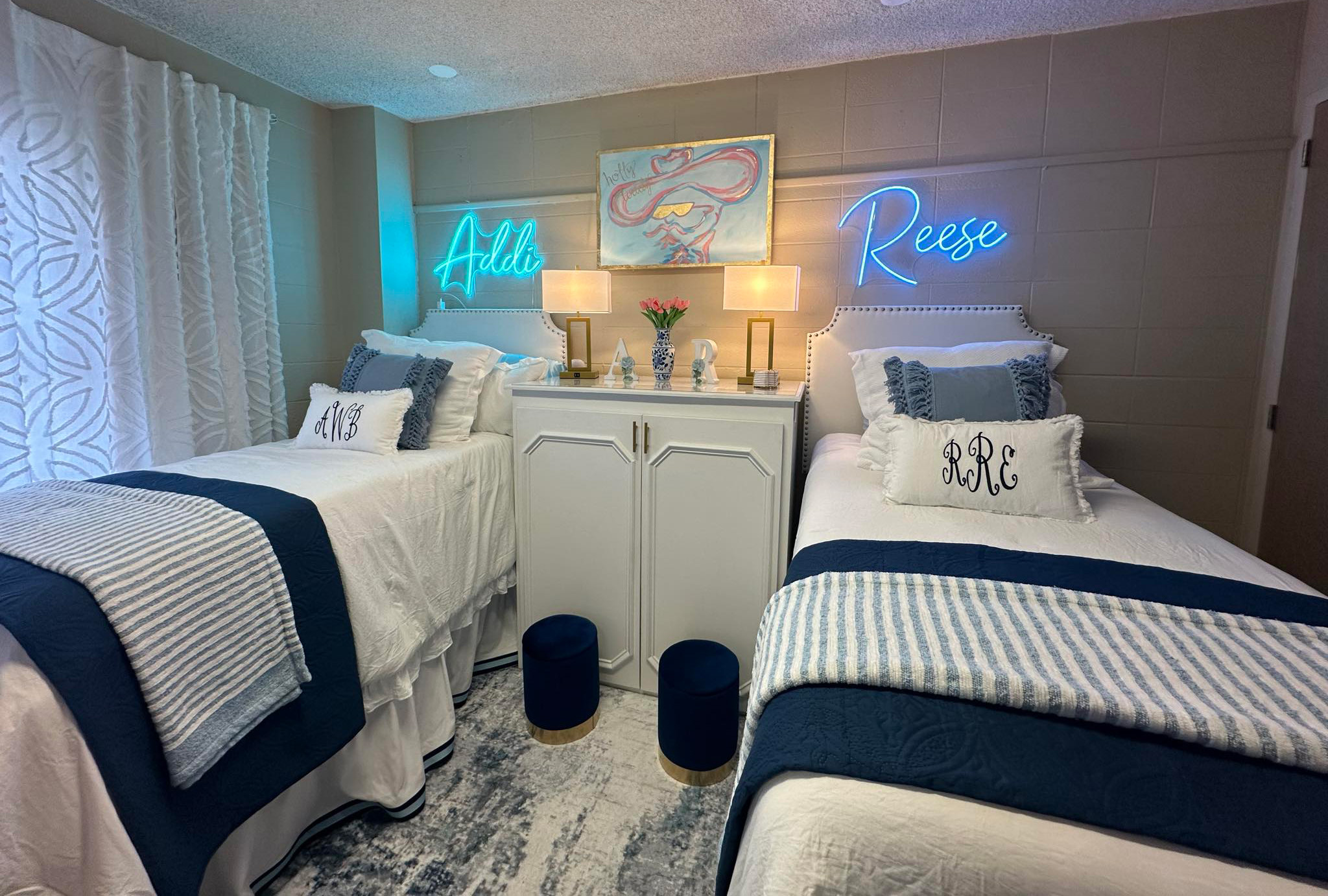I went off to college in the 1990s with the understanding that a dorm room should be as functional as an army barrack and only slightly more luxurious than a bunk at sleepaway camp. If the linoleum was dishwater gray, the twin bed had a bare-bones iron frame, and the walls were cinderblock, I would know I’d entered the lobby of adulthood — and if I moved fast, I could salvage some plastic milk crates and construct a janky-but-serviceable bookcase with them.
Had I called my new roommate several weeks before move-in day to establish a color scheme for our sheets and quilts, I assume the response would have been a very loud dial tone. It was a different time, but I didn’t realize just how different until last week, when someone in my group chat mentioned the Facebook group DormRoomMamas and I slipped down a rabbit hole into the billion-dollar realm of dorm room planning and makeovers. It’s a world where mothers of incoming college freshmen want someone to just tell them the correct number of towels and sheets to shop for, what air purifier has the highest Amazon ratings, and how many framed family photos are appropriate to smuggle into their child’s new living space. It’s a land of mood boards titled “Ottomans for girls,” triple-digit checklists of dorm room “essentials” and terminology like “bed party” and “fridge bridge.”
@theasmithh1 Freshman year dorm😆💖 so blessed @scarlett #minorhall #olemiss #dormtransformation ♬ TELEKINESIS – Travis Scott
It’s a blur of Woozoo fans, Hulkin bags and throw pillows appliqued with CALL YOUR MOM, provided by a mom who hasn’t given you a reason to call yet because she’s right there with a hex wrench, precise room measurements for peel-and-stick wallpaper, and very strong opinions on how to fold underwear. Some of these mothers are professional dorm room stylists (a string of words that probably shouldn’t exist) paid to execute room redesigns that seem more appropriate for luxury Airbnbs than for rooms whose signature scent will be ripe feet. But more of them appear to treat easing the transition from home to college as a calling beyond paid work that compels them to spare little expense in reifying their roles as providers for and protectors of young people on the cusp of change.
I was vaguely aware, during my time in dorms and off-campus apartments, that there was a place called Target that sold closet organizers, cute duvet covers, and framed “Starry Night” prints, but these spaces seemed more often to accumulate furnishings organically — a graduating senior’s futon here, a rug from AmVets there. Dorm rooms were sites of evolution, not re-creations of home; they were liminal spaces where posters, electronics, tapestries and strings of lights shaped like fish or chili peppers were visual shorthand for who their residents were or hoped to become. Dorm decor was a precursor to social media that let students unobtrusively survey their peers’ musical taste, affinity for sports, interest in partying, Greek affiliation and propensity to refer to movies as “cinéma.” If you wanted to sprawl out on a couch, well, that’s what the library was for.
College is generally a time when young adults individuate from their families and hometowns, but a lot of mothers are putting a level of expense and effort into setting up their kids’ dorm rooms that, inadvertently or otherwise, reinforces rather than loosens the proverbial apron strings.
To say that’s changed in the decades since doesn’t quite capture the scale of the consumer-facing shift. Big-box chains like IKEA, Target and Bed Bath & Beyond began marketing heavily to college students in the 2000s, innovating programs that let buyers purchase from one location and pick up at another and publishing standalone Back-to-School catalogs. Alongside them, design blogs and the rise of Tumblr, Instagram and Pinterest midwived the modern dorm aesthetic, which combined low-priced, easy-to-assemble starter furniture with friendly textiles, fun colors, and adaptable, modular storage solutions. And the rise of campus brand ambassadors recruited by clothing, electronic and energy-drink companies meant that each school year brought an infusion of consumers who could guide their impressionable peers into the sightlines of Red Bull and American Eagle in return for swag or even salaries.
@ibbdesign Watch this dorm room Get IBB’d! Our Instant Basic to Beautiful mantra can be applied to any space! It’s always important to focus on function as well as form especially in smaller spaces like dorm rooms and apartments. Getting creative with storage solutions and finding versatile multifunctional pieces is imperative – but make it aesthetic too! As an #interiordesign major and a daughter & granddaughter of interior designers, @jayliegeyer had a clear vision for her freshman #dormroom & we had so much fun helping her execute the design. We’re currently working on more projects with college students & can’t wait to share some sneak peeks with you! *all items available thru @ibbdesign #dormroomdesign #dormroomdecor #dormtour #tcudorm #dormdesign #instantbasictobeautiful #dorminspo #getIBBd #teamIBB #IBBDesign ♬ MILLION DOLLAR BABY (VHS) – Tommy Richman
Start your day with essential news from Salon.
Sign up for our free morning newsletter, Crash Course.
In 2011, an enterprising college student looking to bring a bit more style to student housing joined forces with her mother, the cofounder of a creative agency, to found Dormify, an online dorm-decor retailer that leveraged peer-to-peer marketing via trunk shows, YouTube haul videos and more. In 2015, Target introduced its Made For U College Styler, a digital tool that used quiz results and data scraped from customers’ social-media profiles to put together shoppable, sample dorm rooms. The venerable home-design blog Apartment Therapy introduced Dorm Therapy in 2023 as a destination for everything from shopping checklists and DIY guides to dorm room tours and shoppable roundups. And no ceiling has yet emerged for the market. Despite the expected impact of a “demographic cliff” that began emerging after the Great Recession led to a dip in the American birth rate, the number of incoming college students increases year over year. Spending on furnishing and outfitting dorm rooms, meanwhile, nearly doubled between 2023 and 2024, from $6.7 billion to more than $12 billion.
What groups like DormRoomMamas highlight is the emotion that undergirds this consumer phenomenon. College is generally a time when young adults individuate from their families and hometowns, but a lot of mothers (and it is, for the most part, mothers driving this trend) are putting a level of expense and effort into setting up their kids’ dorm rooms that, inadvertently or otherwise, reinforces rather than loosens the proverbial apron strings. These women approach dorm room makeover season with the set-jawed precision of a military campaign: Their mission is to replicate a sense of home in an 8’ by 12’ box, and they’ll be damned if they’re caught flat-footed, without enough under-bed storage and cheery framed YOU GOT THIS! prints to get the job done.

(Lock Stock/Getty Images) A mom helps her daughter decorate her college apartment.
It’s never actually made explicit, but a running joke in these TikToks is that the students don’t necessarily seem to be requesting the excess. One clip that has racked up more than a million views begins with pink-and-blue bubble text that warns “Mom, don’t go overboard with my dorm decor” over a POV shot of a mostly bare room. Images shuffle in time with anticipatory piano notes and a countdown clock: dorm-supply checklists, half-assembled furniture and snapshots of the mother and daughter through the years. It ends in the passenger seat of a car, presumably about to depart for campus, homing in on a young woman scrolling her phone and eventually offering a tight, distracted smile to the camera. Guess who didn’t listen to the plea about not going overboard?
And, like so much else in an influencer-driven economy, the bar for what’s considered essential to college-dorm life gets higher each fall. In some cases, literally: the use of multiple bed risers to create increasing amounts of storage space has seen beds rise to Princess-and-the-Pea heights, often requiring one separate piece of furniture that allows students to make contact with their mattresses and another to match the exaggerated height. But the sense of competing with other parents to best prepare their new students is pervasive. One mother who began trading texts with the mothers of her son’s soon-to-be roommates detailed the experience in Business Insider, writing that the text circle “turned what should be a rite of passage into something that feels a little more like a wedding registry.” As the other parents “started filling their Amazon carts with things I never even considered buying my sons,” and the roommates themselves offered little input, author Tanya Bricking Leach found herself rethinking who those ever-rising expectations are for.
DORM SWEET DORM: Mom of three goes viral for turning college dorms into dream rooms. pic.twitter.com/oZhaIdL5o1
— FOX & Friends (@foxandfriends) August 26, 2025
I get it: With two years before my own kid starts college, I’m aware that one of the less embarrassing ways to express that visceral blend of love and loss is with tangible, purpose-built products that are both evidence of care and undeniable improvements on past eras of dorm living. (What I would have given for a laundry backpack.) And there are plenty of dorm room inhabitants who are thrilled with the results of their dorm room mama makeovers. But it seems like a couple of things can get lost in focusing on the aesthetic and consumable aspects of the home-to-school transition.
One is individuality. Social media’s category of viral dorm room inspo is heavily female, each room’s jaw-dropping glow-up seeming to share the same components — matching headboards, desks repurposed as vanity tables with Hollywood-style makeup mirrors and more. DormRoomMamas’ gender-specific mood boards and themes (bows! ruffles! wineglasses! Yes, wineglasses!) have an identikit femininity, and the focus on marketing a rigid binary to parents can feel like a rerun of how retailers sell parents on preparing a nursery, right down to accepting that each well-considered element in the room is going to get puked on sooner or later.
There are plenty of dorm room inhabitants who are thrilled with the results of their dorm room mama makeovers. But it seems like a couple of things can get lost in focusing on the aesthetic and consumable aspects of the home-to-school transition.
The other thing lost in aggressively parent-led dorm design is that college itself is a place where attempting and maybe not always succeeding and carrying on anyway is the whole point. It’s hard not to consider what messages rising expectations for dorm prep send to young people in their first days of real independence. “You should never have to experience unfamiliarity,” and “You will always have what you need exactly when you need it” don’t seem like the best takeaways for this stage of young adulthood. As someone who sobbed openly at my kid’s middle-school graduation, I’ve already learned that there’s no skating by the existential overwhelm of raising a child in a time when you can only hope to one day let them go by choice. But anticipating every possible instance of vulnerability my child might face and pre-emptively padding it with stuff won’t do anything to dull a primal, instinctual vigilance.
Of course, there is plenty of space between a dorm room with a sparseness that spotlights the unfamiliarity of a new environment and one that’s filled to bursting with the material evidence of parental involvement. And what the media amplifies in the flurry of pieces on back-to-school hyperconsumption isn’t necessarily the norm. (For the record, my son’s answer to the question “Would you let me plan the design of your hypothetical dorm room?” was a polite but very firm “No.”) Shopping away the uncertainty of the near future has become the unquestioned norm, but being honest about what can and can’t be guaranteed with a picture-perfect new home seems like an important lesson.
Read more
about going to college


